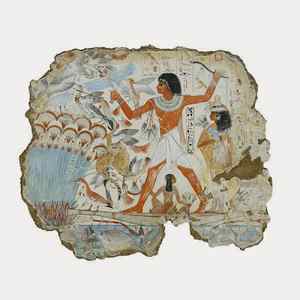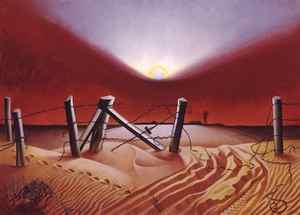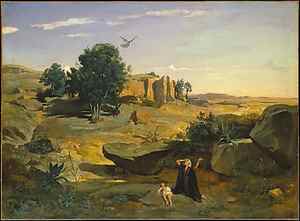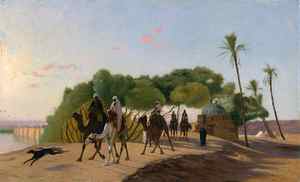Notify me of similar works
Talking Objects
Georgia O’Keeffe’s “Pelvis II” provided the starting point for an examination of differing views of the desert and lead to the conclusion that an artist’s experiences in the desert shape the way they depict it. The desert is typically imagined as a vast plane barren of life and beauty; however, for those who call the desert home it can be a place of beauty and fascination. In paintings the desert ranges from a symbolic backdrop to a worthy subject in itself.
“Pelvis II” reflect the feelings O’Keeffe sees in the desert. O’Keeffe examines the form and shape of the bone, how the abstracted bone mirrors the desert, and how both the bone and the desert share a quiet grandeur. Other artists who live and work in the desert experience the hardship of living in a desert along with the richness of their home landscape. For these artists the desert isn’t a distant place, but home and the location of everyday life. These works may be examinations of the desert itself or of the desert as the place where everyday life goes on. Their depictions range from beauty in the desert to simply the background of life. For those unfamiliar with the desert it functions as a potent symbol. Artists interested in Biblical narratives or stories of saints use the desert as a backdrop for periods of trial and suffering. In these works the desert is not the primary figure, instead the emphasis is placed on the character struggling with their situation.
O’Keeffe Pelvis II 1944
Oil on canvas, Met Museum, Accession Number: 47.19

O’Keeffe’s abstracted depiction of a bovine pelvis mirrors the fascination she has with the desert of her New Mexico home. The dry bone and expanse of sky remind the viewer of the desert in a nonthreatening way. O’Keeffe’s abstraction of the pelvis examines the form of the bone and the way it interacts with its surroundings. This magnified yet isolated bone gives the viewer O’Keeffe’s impression of the desert: not an inhospitable wasteland but an intriguing space to be explored.
Peter Booth, Desert, 1985
oil on canvas, Met Museum, Accession Number: 1986.219

This abstract representation associates the desert with negative feelings of suffering and harshness. The artist, Peter Booth, lived in Australia, and this work is informed both by his perception of Australia’s outback and by the symbolic meaning he wishes to convey. Booth takes the harsh conditions inherent in a desert and amplifies them by adding vicious abstracted forms to the landscape. Instead of painting a particular desert, Booth creates a symbol for the feeling he wishes to convey: this desert is a melding of the true Australian outback along with the messages and meaning Booth created. His experience of the desert is used to convey feelings of despair and isolation.
Unknown Artist, Nebamun hunting in the Marshes, c. 1350 BCE Fragment form tomb chapel of Nebamun, The British Museum, EA37977

Ancient Egyptian art includes the desert as its natural background. For the Egyptian people the desert was their home, there was nothing exceptionally harsh about it, and Egyptian art shows this perception. Egyptian life and their desert home are so intertwined that when present day viewers even look at an Egyptian motif, images of the desert are summoned to their heads. The sandstone brown background is the color the desert; scenes from daily routines displayed on this background evoke the feel of the desert without necessarily depicting the desert itself. Egyptians also show the abundance that is possible in the desert. Part of the tomb-chapel of Nebamun depicts a hunting trip by a river flushing game birds out of the tall reeds. The closeness of Egyptian culture and their land results in careful depiction of their surroundings representing both the hardships and abundances possible.
Alexandre Hogue, Dust Bowl , 1933,
oil on canvas, Smithsonian American Art Museum 1969.123

In “Dust Bowl” the desert itself is the subject of the work: not the desert’s beauty, or artistic forms, but merely its presence. This era dealt with the issue of the dust bowl in the American midwest and Hogue sought to emphasize the misery this situation created. Hogue experienced the desert as something that should not be there, something created by poor agricultural practices and mismanagement of the land. The use of hard lines, harsh light, and an absence of cool colors creates a severe depiction of the landscape. Although the desert is the subject it also is a symbol- one of failure to care for the land and difficult conditions for the people left in the desert.
Camille Corot, Hagar in the Wilderness, 1835
oil on canvas, Met Museum, Accession Number: 38.64

In this painting, the desert functions both as a setting and a symbol. The desert acts as the background of a story- the Biblical narrative of Hagar and her son after they have to leave Abraham. The rendering of the desert emphasizes the desperate nature of Hagar’s situation. She sits in the midst of an expanse sparsely littered with rocks and trees. In Biblical literature a desert often symbolizes trials or separation from God and Corot created a desert to fit both of these roles. Corot’s desert isn’t an examination of a real desert but a creation built to fit his artistic purposes. As an imagined landscape, this desert is not as harsh as an actual desert because it functions as a symbol. Once the viewer associates the landscape with their mental image of a desert they impart their knowledge of the desert to the image to supplement their viewing experience.
Jean-Léon Gérôme, Leaving the Oasis, 1880s
Oil on wood panel, Cleveland Museum of Art

Jean-Léon Gerome traveled to the Middle east and depicted scenes from the everyday that he saw there. He experienced bustling life in the desert and his paintings record the vibrancy possible in desert life. Although a visit to the desert may leave a traveler weary and overwhelmed by the expanse of sand and heat, Gerome was able to find areas of lush life. The mix of neutrals with cooler colors and almost photographic detail of “Leaving the Oasis” make the viewer curious and calls the viewer into the bustle of the scene rather than overwhelming them with the vastness of scorching Sahara. Rather than copying from stories of the desert, Gerome experienced it for himself and through his painting invites the viewer into the richness he encountered in the desert.
Cornelis Cort, St. Jerome Reading in the Desert, 1565
Engraving, Met Museum, Accession Number: 17.50.16-168

Both Dutch art styles and depictions of saints rely on symbolic elements to convey messages through art, and “St. Jerome Reading in the Desert” is influenced by both of these traditions. The desert here is both a symbol of the difficult life St. Jerome lived and the literal landscape for some of Jerome’s travels. Cort’s dramatically craggy rock emphasizes the harshness of the landscape. While it is unlikely Cort ever visited the desert himself he still captures the positive aspects of the desert. Although the trees are a bit ragged there is life in them, and the view behind Jerome’s perch is picturesque. St. Jerome doesn’t appear tortured by his surroundings, rather he appears at peace with them. Cort shows that while the desert can be a challenging place it can also be almost peaceful in its dramatic isolated beauty.
Artistic representation of a desert scene
Notify me of similar works
About the Painting
The saguaro cactus is a stately representation of the southwest. This painting captures the feeling of wide open space you experience in the desert. The distant desert buttes catch the warm light of the setting sun.
This painting was done on 1/8″ canvas board and arrives framed and ready to hang.
Free Domestic Shipping
30-Day Money-Back Guarantee
Help Me Compare Options
“Desert Horizon”
3D Textured Replicas by Erin Hanson
Limited and Open Edition
$79,228,162,514,264,337,593,543,950,335 –
Special Offer
15% OFF
Prints & Replicas
SPOOKY SAVINGS
Use Code Promo Code BOO15
Enter Below At Checkout
Expires Oct 31st
Select Edition
30 x 45 in
- Realistic texture and saturated color
- Semi-gloss varnish
- Limited to an edition of 100
- Luxury framing options
- Signed and numbered by the artist
- Certificate of authenticity
- Realistic texture and saturated color
- Semi-gloss varnish
- Open edition
- Classic framing options
- No signature or certificate included
Select Frame
Gold EH Frame
Gold EH Frame
Select Size
Wrapped Canvas
Add to Cart
Buy Now, Pay Later
with
Enjoy now. Pay later.
Request a Sample
Free Domestic Shipping
30-Day Money-Back Guarantee
Help Me Compare Options
“Desert Horizon”
Fine Art Canvas Prints by Erin Hanson
Open Edition
$79,228,162,514,264,337,593,543,950,335 –
Special Offer
15% OFF
Prints & Replicas
SPOOKY SAVINGS
Use Code Promo Code BOO15
Enter Below At Checkout
Expires Oct 31st
Select Style
30 x 45 in
Select Frame
Gold EH Frame
Select Size
Wrapped Canvas
Add to Cart
Buy Now, Pay Later
with
Enjoy now. Pay later.
Request a Sample
Free Domestic Shipping
30-Day Money-Back Guarantee
Help Me Compare Options
[labelhere]
Artwork Details
The saguaro cactus is a stately representation of the southwest. This painting captures the feeling of wide open space you experience in the desert. The distant desert buttes catch the warm light of the setting sun.
This painting was done on 1/8″ canvas board and arrives framed and ready to hang.
Title: “Desert Horizon”
Year Created: 2018
Medium: Oil on canvas
Original Painting Size: 9 x 12 in
Style: “Open Impressionism” is a new style of painting developed by American artist Erin Hanson. The style is characterized by short, impasto brush strokes that are applied without layering, creating a mosaic or stained-glass appearance to the paintings. The paintings are created with a limited pallette of colors, applied without blending or mixing upon the canvas, which adds a dimension of texture to each brush stroke. Inspired by classic impressionism, pointillism, and post-impressionism, Erin Hanson continues the tradition of impressionism into the modern day with her colorful and vivacious landscape paintings.
Shipping & Returns
Shipping and returns details for original artwork:
A representative of The Erin Hanson Gallery will arrange delivery of your Erin Hanson original oil painting. We will ensure someone is home to receive the artwork before shipping it out. Erin Hanson usually sells half of her original paintings while they are still drying on the dry rack. If your painting is still drying, we will let you know when it is expected to be fully dry and ready to ship (about six to eight weeks after the painting’s completion.)
We guarantee you will love your Erin Hanson artwork! If you aren’t happy with your painting for any reason, we accept exchanges or refunds within thirty days.
If your original oil painting is being displayed at a museum or gallery exhibition, you may still purchase the piece online, and we will ship your painting as soon as the show is over.
Note on varnishing: Erin’s paintings take six to eight weeks to dry, at which time we apply a retouching varnish, which allows the painting to complete the curing process while having a layer of protection against dirt and scuffs. The full curing process for an impasto oil painting takes at least two years. We are happy to assist in applying a final finishing varnish to your Erin Hanson oil painting once it has been dry for at least two years. Here is more information on how to care for your original oil painting.
Shipping and returns details for 3D Textured Replicas:
Erin Hanson’s 3D Textured Replicas are made to order in our state-of-the-art printing facility in McMinnville, Oregon. Please allow up to two weeks for us to make your replica. Erin Hanson personally inspects each 3D Textured Replica to make sure it has the same colors and texture as the original. We will email you a tracking number when your artwork ships.
We guarantee you will love your Erin Hanson artwork! If you aren’t happy with your painting for any reason, we accept exchanges or refunds within thirty days.
Shipping and returns details for canvas prints:
Erin Hanson’s canvas prints are made to order in our state-of-the-art printing facility in McMinnville, Oregon. Please allow up to two weeks for us to make your print. We will email you a tracking number when your artwork ships.
We guarantee you will love your Erin Hanson artwork! If you aren’t happy with your painting for any reason, we accept exchanges or refunds within thirty days.
Packaging: Wooden Crate // Artwork Shipper // Original Artwork Shipper // Rolled in a Tube
Your Artwork Arrival: Please be prepared to receive a large wooden pallet. This is the safest way to ship your large artwork. // Your artwork will arrive in an incredibly strong cardboard box that is custom-made to fit the exact size of your artwork. The artwork floats inside thick foam corners that protect the edges. We have never had a piece of artwork arrive damaged from shipping! // Your artwork will arrive in an incredibly strong artwork shipper that is custom-made to fit the exact size of your painting. The painting floats inside thick foam corners that protect the edges. The inside of the box is lined with puncture-and-shatter-proof ABS plastic. We have never had a piece of artwork arrive damaged from shipping! // Your print will arrive safely rolled in a tube.
Signature Required: We require a signature upon delivery to ensure the safe arrival of your artwork.
Shipping Carrier: FedEx Ground // FedEx Freight
Insurance: Your artwork will be shipped fully insured. If your artwork arrives damaged for any reason, please contact us immediately and we will replace or repair it.
Shipping Cost: We are currently offering free domestic shipping. Please use the shopping cart to calculate international shipping.
About 3D Textured Replicas
Making giclees obsolete with the greatest technological leap since the colored printer, Erin Hanson’s 3D Textured Replicas are the next best thing to an original painting. Erin Hanson’s 3D Textured Replicas are almost indistinguishable from the original painting from a few feet away, capturing the texture of every brushstroke, every weave of the canvas, and the vibrant colors of the original oil painting.
Erin spent three years developing the technology of 3D art printing in a quest to create a fine art print that not only captured her vibrant colors but also reproduced the texture that is so important to her work. Erin Hanson’s 3D Textured Replicas are the most realistic artwork reproductions available today. Every detail of an original oil painting, down to the individual ridges of each brushstroke and the canvas texture itself, is reproduced in these Replicas. The beautifully saturated colors are varnished for added UV protection.
Limited Edition: The Limited Edition 3D Textured Replica is limited to an edition of 100. Once we have printed 100 replicas of this painting, we won’t print any more. We offer Limited Edition 3D Textured Replicas in the same size as the original oil painting (as well as a few other options, both 20% larger and 20% smaller than the original’s size.) We offer Limited Edition 3D Textured Replicas with the same luxury framing options we use for Erin’s original oil paintings. Erin Hanson personally hand-signs and numbers each limited edition replica in gold enamel, and there is a Certificate of Authenticity attached to the back.
Open Edition: The Open Edition 3D Textured Replica is offered with the same framing options as our canvas prints. This artwork is not a limited edition and is not signed by Erin Hanson.
About Canvas Prints
Erin Hanson’s canvas prints have the illusion of texture, and they accurately reproduce the brilliant colors of Erin’s originals. Canvas prints are printed directly onto canvas rolls using our state-of-the-art Epsom printer. These prints do not have texture applied — they are flat prints, but they accurately capture the illusion of texture because of the shadows cast by the paint ridges during photography. The canvas prints come rolled, stretched, or framed and ready to hang.
Canvas Roll: A rolled canvas print arrives in a cylindrical shipping tube. The print will have a black border and some extra canvas to allow for stretching onto 1-1/2” stretcher bars. You can take this rolled print to your local framer for stretching and framing.
Wrapped Canvas: Erin Hanson stretched canvas prints arrive pre-stretched onto 1-1/2” stretcher bars. The sides of the print are printed black. This print can be hung un-framed, as-is, or you may take it to your local framer and have it framed in a floater frame.
Framed Canvas: The framed canvas prints are stretched onto 1-1/2” stretcher bars, and then framed in your choice of floater frame (white, black, gold, or silver.) The floater frames are 3/8” wide, and there is a gap around the print, adding a total of 1-1/2” inches to the overall dimensions of the print.





